Related Research Articles

The Arado Ar 234 Blitz is a jet-powered bomber designed and produced by the German aircraft manufacturer Arado. It was the world's first operational turbojet-powered bomber, seeing service during the final years of the Second World War.

The Vought F7U Cutlass was a United States Navy carrier-based jet fighter and fighter-bomber designed and produced by the aircraft manufacturer Chance Vought. It was the first tailless production fighter in the United States as well as the Navy's first jet equipped with swept wings and the first to be designed with afterburners.

The Sukhoi Su-9 was an early jet fighter built in the Soviet Union shortly after World War II. The design began in 1944 and was intended to use Soviet-designed turbojet engines. The design was heavily influenced by captured German jet fighters and it was subsequently redesigned to use a Soviet copy of a German turbojet. The Su-9 was slower than competing Soviet aircraft and it was cancelled as a result. A modified version with different engines and a revised wing became the Su-11, but this did not enter production either. The Su-13 was a proposal to re-engine the aircraft with Soviet copies of the Rolls-Royce Derwent turbojet as well as to modify it for night fighting, but neither proposal was accepted.
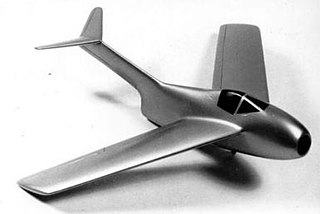
The Focke-Wulf Ta 183 Huckebein was a design for a jet-powered fighter aircraft intended as the successor to the Messerschmitt Me 262 and other day fighters in Luftwaffe service during World War II. It had been developed only to the extent of wind tunnel models when the war ended, but the basic design was further developed postwar in Argentina as the FMA IAe 33 Pulqui II. The name Huckebein is a reference to a trouble-making raven from an illustrated story in 1867 by Wilhelm Busch.

The Messerschmitt P.1101 was a single-seat, single-jet fighter project of World War II, developed as part of the 15 July 1944 Emergency Fighter Program which sought a second generation of jet fighters for the Third Reich. A prominent feature of the P.1101 prototype was that the sweep angle of the wings could be changed before flight, a feature further developed in later variable-sweep aircraft such as the Bell X-5 and Grumman XF10F Jaguar.
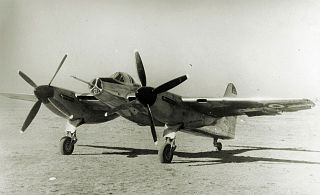
The I.Ae. 30 "Ñancú" was an Argentine twin piston engined fighter designed by the Instituto Aerotécnico in the late 1940s, similar to the de Havilland Hornet, but made of metal rather than wood. Only one prototype was completed; the project was abandoned in favour of the FMA I.Ae. 27 Pulqui I jet aircraft.

The Messerschmitt P.1112 was a proposed German jet fighter, developed by Messerschmitt AG during the closing stages of World War II, and intended for use by the Luftwaffe. The progress of the war prevented the completion of a prototype before the fall of Nazi Germany. Its design, however, had a direct influence on postwar US Navy carrier fighters.
The Alekseyev I-212 was a twin-engined, jet fighter designed in the USSR in 1947 at OKB-21. It was a two-seat variant of the I-21 designed in response to a requirement for a very long-range fighter issued by the Voenno-Vozdushnye Sily (VVS),, in 1946. Intended as an escort fighter, it was also designed for use as a night fighter and reconnaissance aircraft. No prototype was built, although some parts may have begun building before the project was completed.

The Heinkel He P.1079 was a projected German V-tail all weather jet fighter designed by Heinkel Flugzeugwerke in the closing stages of World War II. The aircraft was only a design; it was not produced.

The Arado E.381 was a proposed parasite fighter aircraft. Conceived by Arado Flugzeugwerke in December 1944 for Germany's Luftwaffe during World War II, the E.381 was to have been carried aloft by and launched from an Arado Ar 234 "mother" aircraft. It would then have activated its rocket engine, which would have propelled it to attack Allied bombers. Development was cancelled due to lack of funds and official support.
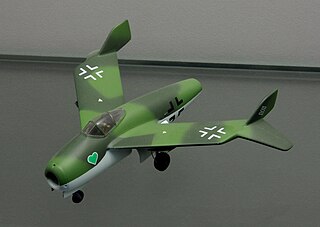
The Blohm & Voss P 212 was a proposed jet fighter designed by Blohm & Voss for the Emergency Fighter Program Luftwaffe design competition during the Second World War.
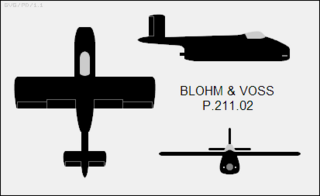
The Blohm & Voss P 211 was a design proposal submitted by Blohm & Voss to the Volksjäger jet fighter competition of the Luftwaffe Emergency Fighter Program towards the end of the Second World War.

The Heinkel P.1078 was a single seat interceptor developed for the Luftwaffe by Heinkel aircraft manufacturing company under the Emergency Fighter Program during the last years of the Third Reich.

The Messerschmitt P.1110 was a design for a single-seat, high-altitude interceptor, prepared for the German Luftwaffe by the Messerschmitt aircraft manufacturing company, under the Emergency Fighter Program during the last months of World War II.
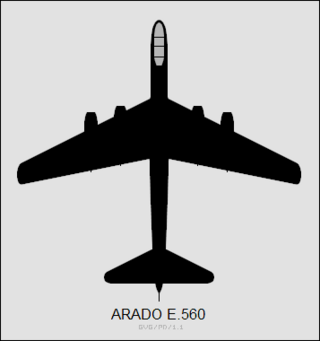
The Arado E.560 was a multi-engined Arado medium-range jet tactical bomber proposed during the Second World War.
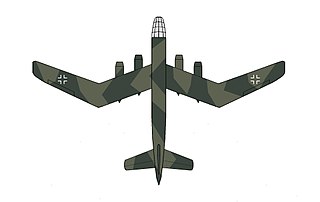
The Blohm & Voss Bv P 188 was a long-range, heavy jet bomber design project by the Blohm & Voss aircraft manufacturing division during the last years of the Third Reich. It featured a novel W-wing planform with variable incidence.

The Gotha Go P.60 was a jet-powered flying wing fighter proposed during World War II by Gothaer Waggonfabrik (Gotha). It was conceived as an improved derivative of the single-seat Horten Ho 229, which Gotha had begun to manufacture as the Go 229. The initial concept a two-seat multi-role fighter that was subsequently developed into a three-seat night and all-weather fighter, but no variant was ever built.
The Blohm & Voss P215 was an advanced jet night fighter project by Blohm & Voss during the Second World War. With a crew of three and twin jet engines, it featured a tailless swept-wing layout and heavy armament. An order for three prototypes was received just weeks before the war ended.
The Messerschmitt P.1107 was a jet-powered bomber project developed in the final years of the Second World War.
References
- ↑ Jim Winchester: F7U Cutlass. International Air Power Review Vol. 15, S. 100.
- ↑ Heinz J. Nowarra (1993), Die deutsche Luftrüstung 1933–1945 (in German), Koblenz: Bernard & Graefe Verlag, ISBN 3-7637-5464-4